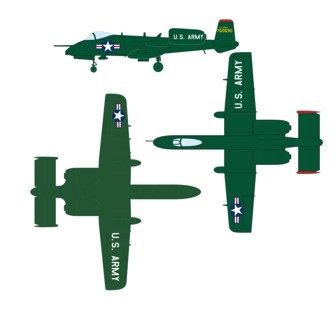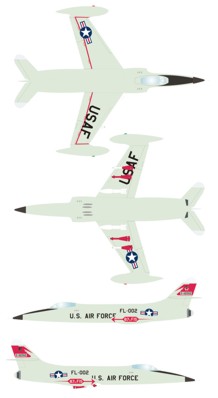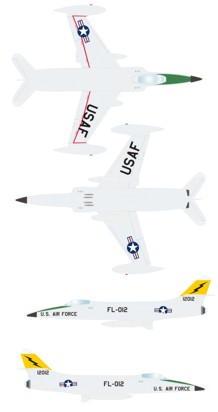What if?
A look at aircraft and color schemes that could have been.
It is not uncommon for people to often wonder what could have been
different if certain events had not occurred or if outcomes had been
different. It is also not uncommon for enthusiasts to speculate
about whether certain aircraft programs would have been successful if
they had been chosen over other aircraft that were successful.
Along that same line of thinking is what if certain color schemes had
been chosen as well. So in that vein here are a few "what if"
scenarios.
 |
As the A-10 was designed as a tank killer there would have been a
certain logic that it should have been operated by the U.S. Army
alongside helicopter gun ships. If current doctrine did not
prohibit the Army from operating fixed wing aircraft the A-10 could
have very well carried the above colors when entering service during
the late 1970s.
 |
For some time there was a not very serious line of speculation on
various newgroups that the RAAF could replace the F-111s then in
service with surplus B-1Bs in storage at AMARG. Though the Bone
would have taken a great deal of resources to keep in operation it
would have looked pretty cool in Aussie markings.
 |
 |
In my personal opinion the none of the schemes carried by the B-1 have
really done justice to the look of the airplane. To correct that
I decided to go retro in a couple of make believe schemes. This
also was done to resurrect a couple of inactivated bomb wings: a
95th Bomb Wing B-1B in the SAC South East Asia scheme and a 97th
BW Bone in the SAC SIOP scheme.
 |
The schemes carried by U.S. Navy aircraft during the 20's and 30's are
some of the most colorful to have ever flown. With many units
painting an aircraft in colorful markings it is a shame that the USN
never chose to paint any in a more colorful era. For this "what
if" scheme I chose an F-14. With the Tomcat long gone maybe an
F-18 might be a better choice.
 |
 |
 |
 |
The F-100 Super Sabre was a workhorse of the Tactical Air Command
serving for over two decades. It also served with several foreign
air forces and would have been a natural with some others.
When the German Luftwaffe was reformed in the 1950's some German officers pushed for the F-100 to be chosen as a replacement for the Canadair Sabres that was the first major post-war aircraft. In the end the F-104 would fill that role. If the Hun had indeed been chosen a natural choice of units to be equipped with it would have been JG71 "Richthofen".
The RCAF chose the superb Canadair Sabre until CF-101 VooDoos and CF-100 Canucks replaced it. Had the Canadian Air Force chosen the F-100 it would have been a good choice for it to equip number 434 Blue Nose squadron.
The RAF operated a good number of Sabre Mk 4s before receiving Hawker Hunters. But, "What if Number 92 and 112 squadrons had gotten F-100s?"
When the German Luftwaffe was reformed in the 1950's some German officers pushed for the F-100 to be chosen as a replacement for the Canadair Sabres that was the first major post-war aircraft. In the end the F-104 would fill that role. If the Hun had indeed been chosen a natural choice of units to be equipped with it would have been JG71 "Richthofen".
The RCAF chose the superb Canadair Sabre until CF-101 VooDoos and CF-100 Canucks replaced it. Had the Canadian Air Force chosen the F-100 it would have been a good choice for it to equip number 434 Blue Nose squadron.
The RAF operated a good number of Sabre Mk 4s before receiving Hawker Hunters. But, "What if Number 92 and 112 squadrons had gotten F-100s?"
 |
 |
 |
 |
With production of the B-36 coming to an end and no major projects in
sight Convair needed a program to keep factories open. The USAF
was in need of a new strategic bomber and Convair engineers felt that
the B-36 airframe could be updated to compete with Boeing's
XB-52. The result was the YB-60, which had a cavernous bomb bay
and a n impressive range. Unfortunately the B-52 was almost
ninety knots faster than the B-60 and all things being considered had
more to offer to the Air Force. Only one YB-60 was flown, a
second airframe was authorized, but never completed.
One of the first assignments for a production B-60s would have been the Air Force Flight Test Center at Edwards AFB.
The B-60 would have gone into service in the early 50's when natural metal and silver finishes would have been the norm. The 6th BW converted from B-36s to B-52Es in 1957. If that conversion had been to the B-60 they could very well have looked like the drawing of the one sporting the "winged two".
As the length of service would have probably been comparable to the early versions of the B-52 it would be safe to assume that the B-60s would have gone through the same evolution as the BUFF. In this imaginary world the 95th BW lost the B-52B and RB-52B and transitioned to the B-60A before deploying to South East Asia then returned home to convert to AGM-28 Hound Dog capable B-60Bs.
One of the first assignments for a production B-60s would have been the Air Force Flight Test Center at Edwards AFB.
The B-60 would have gone into service in the early 50's when natural metal and silver finishes would have been the norm. The 6th BW converted from B-36s to B-52Es in 1957. If that conversion had been to the B-60 they could very well have looked like the drawing of the one sporting the "winged two".
As the length of service would have probably been comparable to the early versions of the B-52 it would be safe to assume that the B-60s would have gone through the same evolution as the BUFF. In this imaginary world the 95th BW lost the B-52B and RB-52B and transitioned to the B-60A before deploying to South East Asia then returned home to convert to AGM-28 Hound Dog capable B-60Bs.
 |
 |
The Lockheed XF-90 was a futuristic looking aircraft that never
achieved its design potential due to the anemic J34 engines
employed. In the "what if" scenario the two J34s have been
replaced with two afterburner equipped J47s. This would have
necessitated larger intakes and after fuselage that could have created
an accidental area rule thereby increasing performance.
One possible use would have been as an interceptor for the Air Defense Command. This would have probably required a larger radar, but the wings woukd have had the strength to carry up to six missiles. "The F-90A equipped the 87th FIS when that unit lost its F-106s to the 58th FIS at Walker AFB. The 87th would later receive the initial batch of F-108A Rapiers" Well, it is a what if world!
Not to be left out, "USAFE equipped the 49th TFW with F-90Cs while awaiting the production version of the F-107A. The F-90 was chosen for its ability to carry two B28EX thermonuclear weapons, though the usual load would only be one with an external tank on the opposite wing."
One possible use would have been as an interceptor for the Air Defense Command. This would have probably required a larger radar, but the wings woukd have had the strength to carry up to six missiles. "The F-90A equipped the 87th FIS when that unit lost its F-106s to the 58th FIS at Walker AFB. The 87th would later receive the initial batch of F-108A Rapiers" Well, it is a what if world!
Not to be left out, "USAFE equipped the 49th TFW with F-90Cs while awaiting the production version of the F-107A. The F-90 was chosen for its ability to carry two B28EX thermonuclear weapons, though the usual load would only be one with an external tank on the opposite wing."


